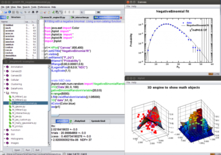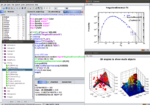DataMelt
Computation and Visualization Environment 2.2 (2018/05/10)
Developed by: DataMelt community. Led by S.Chekanov
License: GPL / GNU for non commercial use. Commercial-friendly license is available
Web page : Tool homepage
Tool type : Application software
The last edition of this page was on: 2014/02/26
The Completion level of this page is : Medium
The last edition of this page was on: 2014/02/26 The Completion level of this page is : Medium
SHORT DESCRIPTION
[[has description::DataMelt is a software environment for numeric calculations, statistics and data analysis
DataMelt, or DMelt, is an environment for numeric computation, data analysis and data visualization. DMelt is designed for analysis of large data volumes ("big data"), data mining, statistical analyses and math computations. The program can be used in many areas, such as natural sciences, engineering, modeling and analysis of financial markets.
DMelt is a computational platform: It can be used with different programming languages on different operating systems. Unlike other statistical programs, DataMelt is not limited by a single programming language. Data analysis and statistical computations can be done using high-level scripting languages (Python/Jython, Groovy, etc.), as well as a lower-level language, such as JAVA. It incorporates many open-source JAVA packages into a coherent interface using the concept of dynamic scripting.
DMelt creates high-quality vector-graphics images (SVG, EPS, PDF etc.) that can be included in LaTeX and other text-processing systems.
Contents
History
DataMelt has its roots in particle physics where data mining is a primary task. It was created as jHepWork project in 2005 and it was initially written for data analysis for particle physics[1] using the Java software concept for International Linear Collider project developed at SLAC. Later versions of jHepWork were modified for general public use (for scientists, engineers, students for educational purpose) since the International Linear Collider project has stalled. In 2013, jHepWork was renamed to DataMelt and become a general-purpose community-supported project. The main source of the reference is the book "Scientific Data analysis using Jython Scripting and Java" [2] which discusses data-analysis methods using Java and Jython scripting. Later it was also discussed in the German Java SPEKTRUM journal [3]. The string "HEP" in the project name "jHepWork" abbreviates "High-Energy Physics". But due to a wide popularity outside this area of physics, it was renamed to SCaViS (Scientific Computation and Visualization Environment). This project existed for 3 years before it was renamed to DataMelt (or, in short, DMelt).
DataMelt is hosted by the jWork.ORG portal[4]
Supported platforms
DataMelt runs on Windows, Linux, Mac and the Android platforms. The package for the Android is called AWork.
Documentation
DataMelt is extensively documented. In 2018, the web page of this project contained about 600 examples written in Jython, Java, Groovy, JRuby, covering a number of fields, from general mathematics to data mining and data visualization. The Java API documentation includes the description of more than 40,000 Java classes. In addition, there is a wiki documentation. The documentation includes certain restrictions for general public due to the proprietorial nature of the documentation project.
License terms
DataMelt is licensed by Freemium license. The core source code of the numerical and graphical libraries is licensed by the GNU General Public License. The interactive development environment (IDE) used by DataMelt has some restrictions for commercial usage since language files, documentation files, examples, installer, code-assist databases, interactive help are licensed by the creative-common license. Full members of the DataMelt project have several benefits, such as: the license for a commercial usage, access to the source repository, an extended help system, a user script repository and an access to the complete documentation.
The commercial licenses cannot apply to source code that was imported or contributed[5] to DataMelt from other authors.]]
TOOL CHARACTERISTICS
Usability
Tool orientation
Data mining type
Manipulation type
IMPORT FORMAT :
EXPORT FORMAT :
| Tool objective(s) in the field of Learning Sciences | |
|
☑ Analysis & Visualisation of data |
☑ Providing feedback for supporting instructors: |
Tool can perform:
- Data extraction of type:
- Transformation of type: Mathematical transformation of data for analysis
- Data analysis of type: Data mining methods and algorithms, Basic statistics and data summarization
- Data visualisation of type: Sequential Graphic, Chart/Diagram, Map (These visualisations can be interactive and updated in "real time")
ABOUT USERS
Tool is suitable for:
Required skills:
STATISTICS: Advanced
PROGRAMMING: Basic
SYSTEM ADMINISTRATION: None
DATA MINING MODELS: Medium
FREE TEXT
| Tool version : Computation and Visualization Environment 2.2 2018/05/10 (blank line) Developed by : DataMelt community. Led by S.Chekanov | 
|
SHORT DESCRIPTION
DataMelt is a software environment for numeric calculations, statistics and data analysis
DataMelt, or DMelt, is an environment for numeric computation, data analysis and data visualization. DMelt is designed for analysis of large data volumes ("big data"), data mining, statistical analyses and math computations. The program can be used in many areas, such as natural sciences, engineering, modeling and analysis of financial markets.
DMelt is a computational platform: It can be used with different programming languages on different operating systems. Unlike other statistical programs, DataMelt is not limited by a single programming language. Data analysis and statistical computations can be done using high-level scripting languages (Python/Jython, Groovy, etc.), as well as a lower-level language, such as JAVA. It incorporates many open-source JAVA packages into a coherent interface using the concept of dynamic scripting.
DMelt creates high-quality vector-graphics images (SVG, EPS, PDF etc.) that can be included in LaTeX and other text-processing systems.
History
DataMelt has its roots in particle physics where data mining is a primary task. It was created as jHepWork project in 2005 and it was initially written for data analysis for particle physics[1] using the Java software concept for International Linear Collider project developed at SLAC. Later versions of jHepWork were modified for general public use (for scientists, engineers, students for educational purpose) since the International Linear Collider project has stalled. In 2013, jHepWork was renamed to DataMelt and become a general-purpose community-supported project. The main source of the reference is the book "Scientific Data analysis using Jython Scripting and Java" [2] which discusses data-analysis methods using Java and Jython scripting. Later it was also discussed in the German Java SPEKTRUM journal [3]. The string "HEP" in the project name "jHepWork" abbreviates "High-Energy Physics". But due to a wide popularity outside this area of physics, it was renamed to SCaViS (Scientific Computation and Visualization Environment). This project existed for 3 years before it was renamed to DataMelt (or, in short, DMelt).
DataMelt is hosted by the jWork.ORG portal[4]
Supported platforms
DataMelt runs on Windows, Linux, Mac and the Android platforms. The package for the Android is called AWork.
Documentation
DataMelt is extensively documented. In 2018, the web page of this project contained about 600 examples written in Jython, Java, Groovy, JRuby, covering a number of fields, from general mathematics to data mining and data visualization. The Java API documentation includes the description of more than 40,000 Java classes. In addition, there is a wiki documentation. The documentation includes certain restrictions for general public due to the proprietorial nature of the documentation project.
License terms
DataMelt is licensed by Freemium license. The core source code of the numerical and graphical libraries is licensed by the GNU General Public License. The interactive development environment (IDE) used by DataMelt has some restrictions for commercial usage since language files, documentation files, examples, installer, code-assist databases, interactive help are licensed by the creative-common license. Full members of the DataMelt project have several benefits, such as: the license for a commercial usage, access to the source repository, an extended help system, a user script repository and an access to the complete documentation.
The commercial licenses cannot apply to source code that was imported or contributed[5] to DataMelt from other authors.
TOOL CHARACTERISTICS
| Tool orientation | Data mining type | Usability |
|---|---|---|
| This tool is designed for general purpose analysis. | This tool is designed for . | Authors of this page consider that this tool is . |
| Data import format | Data export format |
|---|---|
| . | . |
| Tool objective(s) in the field of Learning Sciences | |
|
☑ Analysis & Visualisation of data |
☑ Providing feedback for supporting instructors: |
Can perform data extraction of type:
Can perform data transformation of type:
Mathematical transformation of data for analysis
Can perform data analysis of type:
Data mining methods and algorithms, Basic statistics and data summarization
Can perform data visualisation of type:
Sequential Graphic, Chart/Diagram, Map (These visualisations can be interactive and updated in "real time")
ABOUT USER
| Tool is suitable for: | ||||
| Students/Learners/Consumers:☑ | Teachers/Tutors/Managers:☑ | Researchers:☑ | Organisations/Institutions/Firms:☑ | Others:☑ |
| Required skills: | |||
| Statistics: ADVANCED | Programming: BASIC | System administration: NONE | Data mining models: MEDIUM |
OTHER TOOL INFORMATION

|
| Scavis.png |
| Scavis logo.jpg |
| Computation and Visualization Environment |
| GPL / GNU for non commercial use. Commercial-friendly license is available"GPL / GNU for non commercial use. Commercial-friendly license is available" is not in the list (Artistic License 2.0, Berkeley Database License, Boost Software License, BSD license (modified version), BDL / BSD Documentation License, CeCILL (CEA CNRS INRIA Logiciel Libre), Cryptix General License, Eclipse Distribution License, EUPL - European Union Public License, GPL / GNU General Public License, ...) of allowed values for the "Free software license" property. |
| Free&Open source |
| DataMelt community. Led by S.Chekanov |
| 2018/05/10 |
| 2.2 |
| http://jwork.org/dmelt/ |
| [[has description::DataMelt is a software environment for numeric calculations, statistics and data analysis
DMelt is a computational platform: It can be used with different programming languages on different operating systems. Unlike other statistical programs, DataMelt is not limited by a single programming language. Data analysis and statistical computations can be done using high-level scripting languages (Python/Jython, Groovy, etc.), as well as a lower-level language, such as JAVA. It incorporates many open-source JAVA packages into a coherent interface using the concept of dynamic scripting. DMelt creates high-quality vector-graphics images (SVG, EPS, PDF etc.) that can be included in LaTeX and other text-processing systems. HistoryDataMelt has its roots in particle physics where data mining is a primary task. It was created as jHepWork project in 2005 and it was initially written for data analysis for particle physics[1] using the Java software concept for International Linear Collider project developed at SLAC. Later versions of jHepWork were modified for general public use (for scientists, engineers, students for educational purpose) since the International Linear Collider project has stalled. In 2013, jHepWork was renamed to DataMelt and become a general-purpose community-supported project. The main source of the reference is the book "Scientific Data analysis using Jython Scripting and Java" [2] which discusses data-analysis methods using Java and Jython scripting. Later it was also discussed in the German Java SPEKTRUM journal [3]. The string "HEP" in the project name "jHepWork" abbreviates "High-Energy Physics". But due to a wide popularity outside this area of physics, it was renamed to SCaViS (Scientific Computation and Visualization Environment). This project existed for 3 years before it was renamed to DataMelt (or, in short, DMelt). DataMelt is hosted by the jWork.ORG portal[4] Supported platformsDataMelt runs on Windows, Linux, Mac and the Android platforms. The package for the Android is called AWork. DocumentationDataMelt is extensively documented. In 2018, the web page of this project contained about 600 examples written in Jython, Java, Groovy, JRuby, covering a number of fields, from general mathematics to data mining and data visualization. The Java API documentation includes the description of more than 40,000 Java classes. In addition, there is a wiki documentation. The documentation includes certain restrictions for general public due to the proprietorial nature of the documentation project.
License termsDataMelt is licensed by Freemium license. The core source code of the numerical and graphical libraries is licensed by the GNU General Public License. The interactive development environment (IDE) used by DataMelt has some restrictions for commercial usage since language files, documentation files, examples, installer, code-assist databases, interactive help are licensed by the creative-common license. Full members of the DataMelt project have several benefits, such as: the license for a commercial usage, access to the source repository, an extended help system, a user script repository and an access to the complete documentation. The commercial licenses cannot apply to source code that was imported or contributed[5] to DataMelt from other authors.]] |
| General analysis |
| Advanced |
| Basic |
| None |
| Medium |
| Application software |
| Data transformation, Data analysis, Data visualisation |
| Data mining methods and algorithms, Basic statistics and data summarization |
| Mathematical transformation of data for analysis |
| Sequential Graphic, Chart/Diagram, Map |
| Medium |
- ↑ HEP data analysis using jHepWork and Java, arXiv:0809.0840v2, ANL-HEP-CP-08-53 preprint. CERN preprint, arXiv:0809.0840v2
- ↑ Scientific Data analysis using Jython Scripting and Java. Book. By S.V.Chekanov, Springer-Verlag, ISBN 978-1-84996-286-5, [1]
- ↑ DataMelt – Werkbank für technisch-wissenschaftliche Berechnungen und Visualisierungen mit Java und Jython. by Rohe Klaus. Java SPEKTRUM. (in German) volume 5 (2013) 26-28 [2]
- ↑ jWork.ORG Community Portal focused on Java scientific software. [3]
- ↑ "Contributed Packages (DataMelt Manual)".

